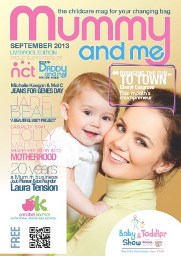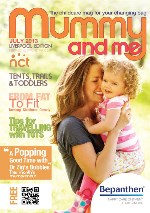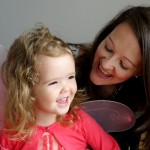Tag: mummy and me magazine
Introducing Your Baby to Dairy
Nutritionally, babies need breastmilk or infant formula until they are one year old. From the age of six months full-fat cow’s milk can be used in cooking and with baby’s breakfast cereals and cow’s milk can be introduced as a main drink from the age of 12 months.

Dairy is an important part of your child’s diet providing essential nutrients such as calcium. When you start weaning your baby at around six months of age you can begin to slowly introduce a variety of foods.
Dairy can be given to baby from the age of six months in the form of cheese but avoid giving blue cheese or soft unpasteurised cheese, such as Camembert and Brie, until your baby is at least one year old. Blue cheese and unpasteurised cheese contain live bacteria which carries the risk of food poisoning.
Yoghurt is a good source of dairy for baby and can be given from the age of six months.
Allergies to Cow’s Milk
Some babies are allergic to cow’s milk so it is important when weaning your baby to introduce foods one at a time over a few days to check for any allergic reactions. You should seek urgent medical help if you think your baby is having an allergic reaction.
A food allergy is when the immune system reacts to a certain food protein resulting in a physical reaction which can occur immediately or within three days.
If your child has cow’s milk allergy the symptoms will start when cow’s milk is introduced into their diet. Symptoms of cow’s milk allergy could result in diarrhoea, vomiting, skin rashes, stomach cramps and difficulty breathing. In rare cases cow’s milk allergy can cause anaphylaxis.
Cow’s milk allergy is a common food allergy in children and most children who have this allergy grow out of it by the age of three, although it is estimated that 20 per cent of adults will continue to have cow’s milk allergy.
Alternatives
Aside from cow’s milk products there are many food sources that contain high levels of calcium. So if your child does have an allergy to dairy products you can still make sure your child’s diet is rich in calcium. Some good sources of calcium rich foods include sesame seeds, sardines canned in oil, spring greens, tofu, watercress and kale.
 Lydia Oliver – Nutritional Advisor Only Best For Baby
Lydia Oliver – Nutritional Advisor Only Best For Baby
This article was published in the September 2013 edition of Mummy and Me Magazine.
I offer one to one nutrition programmes for breastfeeding, post pregnancy weight loss, weaning, weight management and health. Contact me.
Explore, Educate and Eat
Food education is at the forefront of most parents’ minds and is fast becoming a core subject on the school curriculum. I am not surprised there is so much focus on teaching nutrition to children from a young age. Children who learn about food and nutrition are more likely to make healthy food choices and eat fruit and vegetables.
The best and most simple way to get your children thinking about food and nutrition is to get them involved. Here are some simple, daily activities you can do with your children to expand their knowledge about food and make learning fun.
Start with fruit and vegetables
Buy a selection of both and play simple question and answer games that your children will find interesting and educational. What is it? How is it grown? Where does it come from? Could you grow it in your garden or on an allotment?

Experiment
During the week sit down and eat each fruit and vegetable with your children. Talk about whether you can eat it fresh or if it needs to be cooked first. What does it taste like? What colour is it? Ask your children to come up with as many meal ideas as they can that include this fruit or vegetable.
Go green
An easy and engaging project is to try growing fruit, vegetables and herbs with your children. Even if you’re not green fingered, give it a go! All children love to be outside and will learn from the experience of growing something they can eat, plus you could save money growing your own.
Visit a Farmer’s Market
Have a family day out and let your children discover where food comes from and how it is grown. Talk to the growers about their produce and sample the fresh food on offer.
Create
Involve your children in the preparation of their lunch box using fresh ingredients. Cook simple meals and get your children to help where they can, even if they’re simply watching you and talking about what you’re doing. Sit down as a family and enjoy your home cooked food together.
Explore nutrition
Teach your children about the importance of nutrition for a healthy mind and body. Explain why fresh is best.
If you follow these simple steps your children will soon start to take a keen interest in fresh foods and helping you to prepare and cook meals. Regular interaction with food as part of your everyday home life will encourage children to make the right choices for their health.
 Lydia Oliver – Nutritional Advisor Only Best For Baby
Lydia Oliver – Nutritional Advisor Only Best For Baby
This article was published in the August 2013 edition of Mummy and Me Magazine.
I offer one to one nutrition programmes for breastfeeding, post pregnancy weight loss, weaning, weight management and health. Contact me.
National Childhood Obesity Awareness Week
The first week of July is National Childhood Obesity Awareness Week. It is a time when leading organisations aim to highlight the impacts of childhood obesity and request the Government take action to focus on reducing obesity in children, for the health of our nation.
Awareness of childhood obesity and the risks it brings can help parents make better choices for their children. There is a much greater chance that overweight children will become overweight adults, when compared to children who maintain a normal weight throughout adolescence.
Childhood obesity heightens the risk of serious illnesses during childhood and increases the risk of developing long-term health conditions such as type 2 diabetes, heart disease, stroke and several types of cancer.

As a parent there is plenty that you can do to help your child maintain a healthy weight with the support of healthcare professionals and schools. Many teaching institutions now provide an environment where your child can learn about nutrition and health.
Healthy living starts at home and children learn first and foremost from their parents.
Here are some easy ways to assist your child to achieve a healthy weight:
1. Monitor your child’s weight. The ‘red book’ you are given when your baby is born contains useful charts for reviewing your child’s weight, height and development. Always seek professional help if you are concerned about any aspect of your child’s health and development.
2. Encourage your child to exercise and have fun outdoors every day.
3. Feed your child a healthy diet high in vegetables, fruit and unprocessed foods. Minimise the amount of packaged food, fresh is best.
4. Enjoy food in moderation and limit sweet treats to special occasions.
5. Have fun teaching your child about nutritious foods and show them how to cook healthy meals so they are prepared to make the best choices in life.
6. Be a role model for your child and encourage physical activity and healthy eating.
If your child is overweight, you can do something about it. The earlier you act the sooner your child will reap the health benefits, both mentally and physically.
 Lydia Oliver – Nutritional Advisor Only Best For Baby
Lydia Oliver – Nutritional Advisor Only Best For Baby
This article was published in the July 2013 edition of Mummy and Me Magazine.
I offer one to one nutrition programmes for breastfeeding, post pregnancy weight loss, weaning, weight management and health. Contact me.




